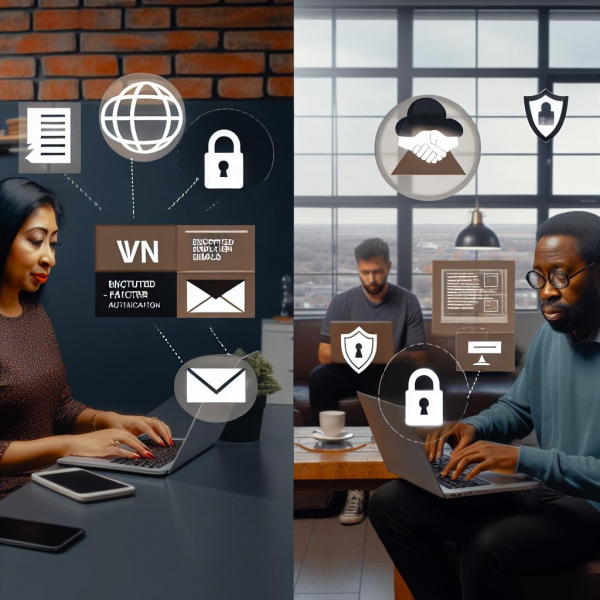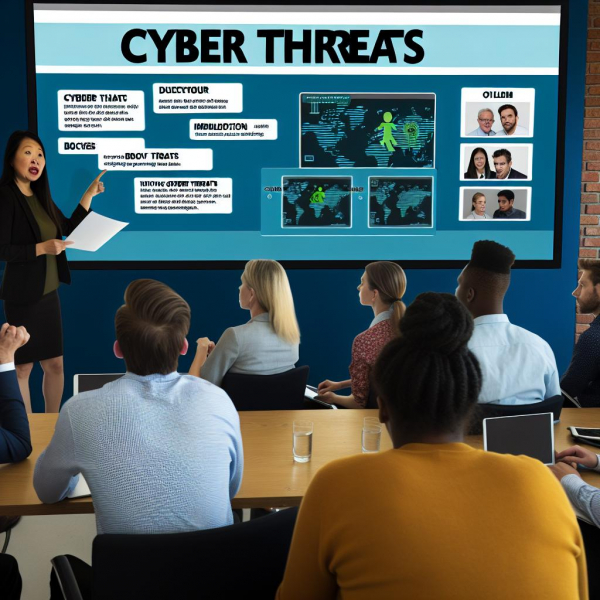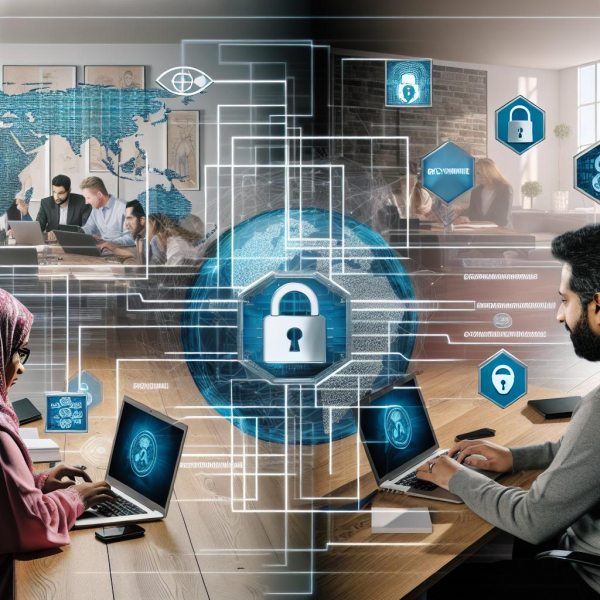As sunlight seeps through the dawn and birds chirp, an army awakens. Clad in pajamas and armed with laptops, they embark on a mysterious journey into the virtual realm, where danger lurks behind every pixel. They are the remote employees, the new frontiersmen of the professional world, navigating uncharted territories of cyberspace. In this era of unprecedented connectivity, the safety of these digital nomads becomes paramount. Join us as we unveil the secrets, the tricks, and the sorcery to safeguarding remote employees from the twisted claws of potential cyber threats. This article unveils the hidden armor, reveals the spells to cast, and equips both employers and employees alike with the knowledge to repel anything the dark abyss of cyberspace may throw at them. So buckle up, for the expedition into the realm of cyber safety is about to commence.
Table of Contents
- Important Measures to Ensure the Cybersecurity of Remote Employees
- Identifying and Educating Employees about Cyber Threats
- Implementing Secure Remote Access Solutions for Remote Workers
- Utilizing Multi-Factor Authentication for Enhanced Cybersecurity
- Regularly Updating and Patching Software for Remote Employees
- Monitoring and Managing Remote Employee Devices for Security Risks
- Establishing a Comprehensive Incident Response Plan for Remote Employees
- Q&A
- To Conclude

Important Measures to Ensure the Cybersecurity of Remote Employees
With the rise of remote work, ensuring the cybersecurity of employees working from home has become more critical than ever. As cyber threats continually evolve, it is vital for businesses to implement important measures to safeguard sensitive data and protect remote employees from potential cyber attacks.
Here are some effective strategies that organizations can employ to enhance the cybersecurity of their remote workforce:
- Provide comprehensive cybersecurity training: Educate your remote employees about the latest cyber threats and how to identify and respond to potential risks. Conduct regular training sessions covering best practices such as creating strong passwords, recognizing phishing emails, and securely utilizing company devices and networks.
- Use multi-factor authentication (MFA): Implement MFA to add an extra layer of security to remote employee accounts. By requiring additional verification steps, such as a fingerprint or unique code, even if an attacker gains access to an employee’s login credentials, they won’t be able to penetrate the account without the additional authentication.
- Enforce secure remote connections: Ensure that remote employees connect to the company network using secure virtual private network (VPN) connections. VPNs encrypt internet traffic, making it much more difficult for attackers to intercept and exploit data.
- Regularly update software and systems: Keep all software and systems up to date with the latest security patches and upgrades. This includes operating systems, antivirus programs, firewalls, and any other software used by remote employees. Outdated software can have vulnerabilities that cybercriminals could exploit.
- Monitor and detect potential threats: Implement robust monitoring systems to detect any suspicious activities or potential cyber threats. Use intrusion detection systems (IDS) and security information and event management (SIEM) solutions to constantly monitor network traffic, identify anomalies, and respond promptly to any threats detected.
By implementing these essential cybersecurity measures, businesses can protect their remote employees and minimize the risk of falling victim to cyber attacks. Remember, maintaining strong cybersecurity practices is an ongoing effort that requires continuous evaluation, adaptation, and a proactive approach to ensure the safety of both your remote workforce and your valuable data.

Identifying and Educating Employees about Cyber Threats
One of the most critical aspects of remote work in today’s digital age is ensuring the safety and security of your employees’ online activities. With the increase in cyber threats, it is essential for organizations to identify and educate their employees about potential risks. By taking proactive measures, you can keep your remote employees safe from potential cyber threats and secure your company’s sensitive information.
To effectively identify and educate employees about cyber threats, consider implementing these strategies:
- Regular Training Sessions: Conduct regular training sessions to educate employees about the latest cyber threats, such as phishing, malware, and social engineering. Provide them with practical examples and guidelines on how to identify and respond to these threats.
- Strong Password Policies: Enforce strong password policies that require employees to create complex passwords and change them periodically. Encourage the use of password managers to ensure secure password management.
- Multi-Factor Authentication (MFA): Implement multi-factor authentication for all remote access systems. This adds an extra layer of security by requiring employees to verify their identity using a second factor, such as a fingerprint or a one-time password.
To further enhance cybersecurity awareness, create a system that allows employees to report any suspicious activities without fear of retribution. This will encourage a culture of openness and facilitate the prompt identification and mitigation of potential cyber threats. Remember, a well-educated and vigilant remote workforce is the first line of defense against cyber attacks.

Implementing Secure Remote Access Solutions for Remote Workers
Remote work has become more prevalent, but it also poses significant cybersecurity challenges. To ensure the safety of remote employees from potential cyber threats, implementing secure remote access solutions is crucial. These solutions enable workers to connect to their company’s network securely from any location, minimizing the risk of data breaches and unauthorized access.
One effective way to provide secure remote access is through the use of virtual private networks (VPNs). By encrypting internet traffic, VPNs create a secure tunnel between the remote worker’s device and the company’s network, shielding sensitive information from potential hackers. Additionally, implementing strong password policies and multi-factor authentication helps to ensure that only authorized individuals can access company resources remotely. Employers should also establish clear security protocols and guidelines for remote workers, educating them on best practices for safe online behavior and recognizing and reporting potential cyber threats.
In addition to VPNs, another solution to consider is remote desktop access. This allows employees to remotely access their work computers and applications. By keeping company data and applications on a centralized server, organizations can better control access and security. Furthermore, utilizing web filtering and malware protection tools helps to detect and prevent potential cyber threats, adding an extra layer of protection for remote workers. By implementing these secure remote access solutions, companies can empower their remote employees to work effectively and confidently, while minimizing the risk of cyber attacks.
Utilizing Multi-Factor Authentication for Enhanced Cybersecurity
As more and more employees are working remotely, ensuring their online safety from potential cyber threats becomes a top priority for organizations. One effective way to enhance cybersecurity is by utilizing multi-factor authentication (MFA). This powerful security measure adds an extra layer of protection to employees’ online accounts, making it more difficult for hackers to gain unauthorized access.
MFA works by requiring users to provide two or more pieces of identification before granting access to their accounts. This typically includes something the user knows (like a password), something they have (like a smartphone or a security token), or something unique to them (like a fingerprint or facial recognition). By combining multiple factors, MFA significantly decreases the chances of a cybercriminal successfully impersonating an employee and infiltrating their accounts.
Implementing MFA within your organization is simple and highly effective. With the help of a reliable identity and access management (IAM) solution, administrators can easily set up MFA for all employees. By doing so, you take a proactive approach towards safeguarding sensitive data and preventing costly security breaches. Don’t wait for a cyber attack to occur; protect your remote employees with the power of multi-factor authentication.
Regularly Updating and Patching Software for Remote Employees
Regularly updating and patching software is crucial for ensuring the security of remote employees. By keeping their software up to date, you are effectively closing any vulnerabilities that hackers could exploit. Here are some best practices to follow:
Automation is key: Implementing an automated software update system can simplify the process and ensure that no updates are missed. This can be done through a trusted IT management tool or using built-in update features provided by the software vendors.
Prioritize critical updates: Not all software updates are equally important. Make sure to prioritize critical updates that address security vulnerabilities or fix known bugs. Keep a close eye on security bulletins provided by software vendors to stay informed about any potential threats that could affect your remote employees.
To further enhance the security of remote employees, consider implementing a robust password policy. Encourage the use of strong passwords and two-factor authentication to add an extra layer of protection. Additionally, invest in regular employee training to raise awareness about common security threats, such as phishing attempts or social engineering tactics. Remember, ensuring the safety of your remote workforce starts with regularly updating and patching software, but it doesn’t end there. Stay vigilant and implement additional security measures to stay one step ahead of potential cyber threats.
Monitoring and Managing Remote Employee Devices for Security Risks
In today’s digital landscape, businesses are increasingly relying on remote employees to keep operations running smoothly. While this arrangement offers flexibility and convenience, it also poses unique security risks that organizations must address. is crucial to protect sensitive data and prevent potential cyber threats.
To ensure the safety of remote employees from these potential threats, organizations can follow several best practices. First, it is essential to establish clear security policies and guidelines that remote employees must adhere to. These policies should include guidelines for strong password creation, regular software updates, and the use of virtual private networks (VPNs) to encrypt internet connections.
- Implementing multi-factor authentication: Require remote employees to use multi-factor authentication for all company accounts to add an extra layer of security.
- Regularly conducting security awareness training: Educate remote employees about common cyber threats, such as phishing attacks, and provide guidance on how to identify and respond to them.
- Monitoring device activity: Utilize monitoring tools to track remote employees’ device activity, including software installations and network connections, to identify and address any suspicious behavior.
By actively , organizations can significantly reduce their vulnerability to cyber threats and protect the integrity of their data. It is crucial to prioritize cybersecurity in today’s increasingly interconnected work environment to safeguard both the interests of the company and the well-being of remote employees.
Establishing a Comprehensive Incident Response Plan for Remote Employees
As organizations continue to embrace remote work, ensuring the safety of employees from potential cyber threats becomes even more crucial. With sensitive company data now being accessed outside the traditional office environment, it is imperative to have a comprehensive incident response plan in place. This plan will not only mitigate the risks associated with cyberattacks but also provide remote employees with the support they need to navigate potential threats.
To establish a robust incident response plan for remote employees, consider the following key steps:
- Evaluate Vulnerabilities: Begin by thoroughly assessing the vulnerabilities that remote employees may be exposed to. This may include insecure home networks, unauthorized device access, or phishing attacks targeting personal email accounts. Identifying these vulnerabilities will provide a clear understanding of the potential threats that need to be addressed.
- Define Incident Categories: Categorize incidents according to their severity and impact on remote employees and the organization as a whole. This will help prioritize responses and allocate appropriate resources. For example, incidents can be classified as low, medium, or high based on the level of urgency and potential damage.
To further enhance the incident response plan, create a table to define incident categories:
| Incident Category | Severity | Impact |
|---|---|---|
| Low | Minor | Minimal impact on employee or organization |
| Medium | Moderate | Significant impact on employee or organization |
| High | Critical | Severe impact on employee or organization, immediate action required |
By incorporating these steps and defining incident categories, organizations can establish a comprehensive incident response plan that effectively safeguards remote employees from potential cyber threats. Remember, a proactive approach to cybersecurity is key to maintaining a secure remote work environment.
Q&A
Q: How can I ensure the safety of my remote employees from potential cyber threats?
A: Protecting remote employees from cyber threats is crucial in this digital age. Here’s how you can keep them safe:
Q: What are some effective ways to safeguard remote employees against cyber threats?
A: There are several measures you can take to ensure the security of your remote employees. Here are a few:
Implement robust cybersecurity policies: Develop comprehensive policies that address topics like password management, software updates, and safe browsing practices. Educate your employees about these policies to create a culture of security awareness.
Use strong encryption: Encourage your employees to use encrypted communication channels for sensitive data transmission. Tools like virtual private networks (VPNs) and encrypted messaging apps can keep their information secure.
Enable two-factor authentication (2FA): Two-factor authentication adds an extra layer of security by requiring employees to provide a second verification factor, such as a unique code or fingerprint, along with their password.
Regularly update security software: Encourage employees to update their devices’ security software regularly to protect against the latest threats. This includes antivirus software, firewalls, and operating systems.
Conduct cybersecurity training: Organize regular training sessions for your remote employees to educate them about various cyber threats, phishing scams, and best practices for staying safe online. This will help them to identify and handle potential risks effectively.
Q: How can remote employees maintain robust password hygiene?
A: Strong and unique passwords are essential to keep cyber threats at bay. Here are a few tips for your remote employees:
Use unique passwords: Encourage your employees to avoid reusing passwords across multiple platforms. Each account should have a distinct and complex password.
Implement password managers: Suggest the use of password manager tools that generate and securely store passwords, reducing the need for employees to remember them all.
Enable multi-factor authentication (MFA): Urge employees to enable MFA wherever possible. It adds an extra layer of security by requiring additional verification beyond a password.
Regularly update passwords: Employees should change their passwords on a regular basis, ideally every three to six months.
Q: Are there any specific precautions for remote employees when using public Wi-Fi?
A: Absolutely. Public Wi-Fi networks can often be hotspots for cyberattacks. Here are some precautions for your remote employees:
Use a VPN: Encourage your employees to always connect to a virtual private network (VPN) when using public Wi-Fi. This encrypts their data and ensures a secure connection.
Avoid accessing sensitive information: Instruct employees not to access or share sensitive data, such as financial information or company documents, when connected to public Wi-Fi.
Verify network legitimacy: Advise employees to verify with the venue staff that they are connecting to the correct Wi-Fi network. Attackers often set up fake networks with similar names to trick users.
Disable automatic Wi-Fi connections: Remind employees to disable the ”auto-connect” feature on their devices, as this could automatically connect them to unsecure networks without their knowledge.
Remember, keeping remote employees safe from cyber threats requires a combination of robust security measures, ongoing training, and employee vigilance. Stay proactive to ensure the digital well-being of your remote workforce.
To Conclude
As we reach the conclusion of this riveting journey into the realms of cyber safety for remote employees, we emerge with a newfound understanding and appreciation for the importance of vigilance in the digital age. It is no secret that the technological landscape has expanded exponentially, creating opportunities, connectivity, and yes, even threats.
In this vast digital universe, our remote employees are like intrepid explorers, charting uncharted territories from the comfort of their own homes. They are the heroes of modern work-life, armed with their laptops and cup of coffee, braving the unknown dangers that lurk in the depths of the internet.
But fear not, for armed with knowledge and a dash of caution, we can equip these brave individuals with the tools needed to face these virtual adversaries head-on. By implementing the best practices we have been bestowed with during this enlightening discourse, we empower our remote workforce to navigate those treacherous virtual waters with confidence and resilience.
Remember, dear leaders and guardians of remote employees, that the quest for cyber safety is an ongoing journey. As we adapt to ever-evolving technological landscapes, so too must we evolve our strategies for protection. Stay updated, remain vigilant, and encourage an environment of open communication where employees feel safe reporting any suspicious cyber activities.
And so, with this knowledge and renewed determination, let us spread our wings and glide towards the digital horizon, secure in the knowledge that we have armed our remote teams with the armor of cyber resilience. Together, we can create a fortress against potential cyber threats, ensuring a safer and more prosperous future for all.
So go forth, fellow cyber warriors, and may your remote employees be forever shielded from the perils that lurk in the shadows of the virtual realm. Stay safe, stay secure, and remember, together we can conquer any digital adversity that comes our way.
